|
|
|
Sort Order |
|
|
|
Items / Page
|
|
|
|
|
|
|
| Srl | Item |
| 1 |
ID:
177332


|
|
|
|
|
| Summary/Abstract |
Within flow-based market coupling, the EU's preferred method for calculating cross-border trading capacities, recent regulatory changes stipulate minimum trading capacities, so-called minRAMs which have to be provided to electricity markets. Effectively, high predicted flows on considered electricity grid elements have to be reduced to reserve a minimum of the elements' capacities for cross-zonal trading. This analysis investigates if the adjustments made to meet this criterion, in the form of augmented trading domains, lead to higher amounts of curative congestion management. To quantify the effect of increasing minRAMs on overall welfare, the markets and grids of Central Western Europe are analyzed during two representative weeks of 2016. The results show the increasing market coupling welfare is more than offset by rising congestion management costs, leading to net welfare losses. In the best case, the generation plus congestion management costs within Central Western Europe rise by 7.25% when increasing the minRAMs from the current 20%–45% and a minRAM of 70% is 6.28% more expensive compared to a minRAM of 20%. The analysis derives policy recommendations for implementing the minRAM stipulation, with a particular focus on a cost-minimizing selection of generation shift keys, in general as well as situation-dependent terms.
|
|
|
|
|
|
|
|
|
|
|
|
|
|
|
|
| 2 |
ID:
103482
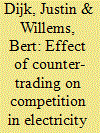

|
|
|
|
|
| Publication |
2011.
|
| Summary/Abstract |
In a competitive electricity market, nodal pricing is the most efficient way to manage congestion. Counter-trading is inefficient as it gives the wrong long term signals for entry and exit of power plants. However, in a non-competitive market, additional entry will improve the competitiveness of the market, and will increase social benefit by reducing price-cost margins. This paper studies whether the potential pro-competitive entry effects could make counter-trading more efficient than nodal pricing. We find that this is unlikely to be the case, and expect counter-trading to have a negative effect on overall welfare. The potential benefits of additional competition (more competitive prices and lower production cost) do not outweigh the distortions (additional investment cost for the entrant, and socialization of the congestion cost to final consumers).
|
|
|
|
|
|
|
|
|
|
|
|
|
|
|
|
| 3 |
ID:
117008
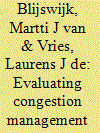

|
|
|
|
|
| Publication |
2012.
|
| Summary/Abstract |
Due to the increase in electricity generation capacity in the Netherlands and a new connection policy, transmission system operator (TSO) TenneT expects a significant increase in congestion in the Dutch transmission grid. To manage this, the Dutch government implemented redispatching, a method which is argued in the literature to potentially impose large congestion costs upon the TSO. A quantitative model of the Dutch electricity system was developed in order to evaluate this method. The outcomes were compared to the performance of three alternative congestion management methods. Regardless of the method, congestion costs were found to be substantially lower than in previous studies. Because combined-cycle gas turbines are the marginal generation technology in almost all cases, the costs of up and down regulation do not differ much. Consequently, the redispatching costs for the TSO are expected to be relatively low, and the opportunities for abuse of market power appear to be limited. While all the evaluated methods are effective and economically efficient, they have significantly different welfare effects. Market splitting creates significantly larger welfare effects than the different varieties of redispatching.
|
|
|
|
|
|
|
|
|
|
|
|
|
|
|
|
| 4 |
ID:
174958
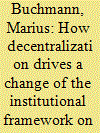

|
|
|
|
|
| Summary/Abstract |
The increasing share of renewables in the electricity system results in congestion on all network levels. To address this congestion, the EU Commission proposed that distribution network operators become responsible for local congestion management. Within this paper we analyze the institutional implications of the introduction of local congestion markets (also referred to as flexibility markets) and identify three discrimination concerns related to the DSO's role on these markets. We will argue that the standard governance models (legal unbundling, ownership unbundling, IDSO) do either not sufficiently address the identified discrimination concerns, or come with additional challenges which make their application less feasible. Instead, we discuss two novel approaches: The introduction of Independent Distribution Operators (IDO) or alternatively, a Common Flexibility Platform (CFP). While the IDO results in a change of the regulatory regime in Europe, the CFP could be applied given the current European unbundling rules. Since the CFP does not require stronger unbundling of DSOs, we recommend to investigate this solution further.
|
|
|
|
|
|
|
|
|
|
|
|
|
|
|
|
| 5 |
ID:
099301
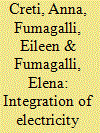

|
|
|
|
|
| Publication |
2010.
|
| Summary/Abstract |
In this paper, we analyze the current trend towards a higher degree of market integration in Europe and identify those aspects that are particularly relevant for Italy. The Italian involvement in this process appears comparatively modest. A welfare analysis, which focuses specifically on the integration of the Italian market, will certainly be a useful support to any policy decision. We argue that, given the peculiarities of the Italian market design, a volume coupling solution could avoid, at the moment, the costs of what could be a significant harmonization effort and, in the end, it might constitute the best short-term strategy. This proposal should be adequately considered, taking into account the complexity of designing an efficient volume-only coordination procedure.
|
|
|
|
|
|
|
|
|
|
|
|
|
|
|
|
| 6 |
ID:
179675


|
|
|
|
|
| Summary/Abstract |
Local flexibility markets have a substantial potential to unlock the flexibility of distributed energy resources in the distribution level. Capacity limitation services have been perceived as one of the most appealing products to be traded in these markets. This work argues why classical market-clearing and pricing mechanisms such as pay-as-bid, uniform pricing and Vickrey-Clarke-Groves (VCG) are not compatible with a market that trades capacity limitations. As a solution, we propose a local flexibility market mechanism which is built upon an adapted VCG-based auction. The mechanism achieves a trade-off among various desirable economic properties, including budget-balancedness, incentive-compatibility and stability. The suitability of the proposed mechanism is illustrated using a case study which is based on a real medium voltage feeder, located on the Danish island of Bornholm. Results show that aggregators and the distribution system operator benefit from the trade of capacity limitation services. We eventually conclude by providing a set of policy recommendations for the real-life operation of such a market.
|
|
|
|
|
|
|
|
|
|
|
|
|
|
|
|
| 7 |
ID:
171384


|
|
|
|
|
| Summary/Abstract |
Strongly increasing costs of congestion management have provoked a discussion in Europe about new approaches to solve grid congestions in a more efficient way. One approach is to design flexibility markets. In this paper we focus on the effects of subsidies for renewable energy on the market outcome of a flexibility market. We show that subsidies can cause market distortions and lead to an inefficient selection of flexibility options to solve grid congestions. We propose the implementation of side payments together with price caps and uniform pricing to achieve an efficient market design. Ultimately choosing between flexibility markets with and without side payments involves a tradeoff between minimizing system costs and maximizing renewable infeed. Our analysis provides the framework for a conscious political choice on that subject.
|
|
|
|
|
|
|
|
|
|
|
|
|
|
|
|
| 8 |
ID:
169843
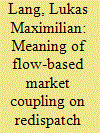

|
|
|
|
|
| Summary/Abstract |
Energy market modelling lacks an approach that tackles the implications of flow-based market coupling on congestion management in European electricity markets. Especially in the context of high shares of renewable energy, the topic of network congestion is becoming even more important. Usually, redispatch measures as a main part of congestion management are calculated on the basis of a simple load flow model incorporating net transfer capacities on the day-ahead market. In this paper, we suggest a modelling approach that incorporates the attributes of flow-based market coupling in the calculation of congestion management. An advanced load flow model is therefore already used to reflect the allocation process on the spot market. Retaining this result, necessary congestion management can be calculated on the basis of a more detailed network model representing the control areas’ exact transmission lines. Also, we conduct a comparison between the net transfer capacity- and the flow-based market coupling approach representing different levels of grid-granularities to show the importance of the grid model used for allocation on the European market for electricity. The results suggest, that necessary congestion management in the system is heavily dependent on the grid granularity, both in the sign and magnitude.
|
|
|
|
|
|
|
|
|
|
|
|
|
|
|
|
| 9 |
ID:
150620


|
|
|
|
|
| Summary/Abstract |
In liberalized electricity markets we observe different approaches to congestion management. While nodal pricing is implemented in Canada and some markets in the United States, European markets are split up into a limited number of price zones with uniform prices, in order to at least partially realize the benefits of regional price differentiation. Zonal boundaries often coincide with national borders, but some countries are also split into multiple zones. In this paper we shed light on possible negative welfare effects of market splitting that arise in a model where investment incentives in new generation capacity are taken into account if zones are misspecified. We show that standard approaches to configure price zones – on the basis of projected nodal price differences or congested transmission capacity – may fail to suggest reasonable zone specifications. Also an adjustment of Available Transfer Capacities (ATCs) between zones or a switch to flow-based market splitting does not ensure positive welfare effects. Our analysis suggests that a careful and detailed evaluation of the system is needed to ensure a reasonable zone configuration.
|
|
|
|
|
|
|
|
|
|
|
|
|
|
|
|
| 10 |
ID:
177321
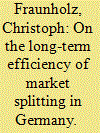

|
|
|
|
|
| Summary/Abstract |
In Europe, the ongoing renewable expansion and delays in the planned grid extension have intensified the discussion about an adequate electricity market design. Against this background, we jointly apply an agent-based electricity market model and an optimal power flow model to investigate the long-term impacts of splitting the German market area into two price zones. Our approach allows capturing long-term investment and short-term market behavior under imperfect information. We find strong impacts of a German market splitting on electricity prices, expansion planning of generators and required congestion management. While the congestion volumes decrease significantly under a market split in the short term, the optimal zonal configuration for 2020 becomes outdated over time due to dynamic effects like grid extension, renewable expansion and new power plant investments. Policymakers and regulators should therefore regularly re-assess bidding zone configurations. Yet, this stands in contrast to the major objective of price zones to create stable locational investment incentives.
|
|
|
|
|
|
|
|
|
|
|
|
|
|
|
|
| 11 |
ID:
096615


|
|
|
|
|
| Publication |
2010.
|
| Summary/Abstract |
We analyze the impact of extensive wind development in Germany for the year 2015, focusing on grid extensions and price signals. We apply the electricity generation and network model ELMOD to compare zonal, nodal, and uniform pricing approaches. In addition to a reference case of network extensions recommended by the German Energy Agency (Dena), we develop a scenario to transmit wind energy to major load centers in Western and Southern Germany via high-voltage direct current (HVDC) connections. From an economic-engineering standpoint, our results indicate that these connections are the most economic way to manage the integration of large-scale offshore wind resources, and that nodal pricing is most likely to determine the locales for future investment to eliminate congestion. We conclude with a description of the model's potential limitations.
|
|
|
|
|
|
|
|
|
|
|
|
|
|
|
|
| 12 |
ID:
097458


|
|
|
|
|
| Publication |
2010.
|
| Summary/Abstract |
We analyze the impact of extensive wind development in Germany for the year 2015, focusing on grid extensions and price signals. We apply the electricity generation and network model ELMOD to compare zonal, nodal, and uniform pricing approaches. In addition to a reference case of network extensions recommended by the German Energy Agency (Dena), we develop a scenario to transmit wind energy to major load centers in Western and Southern Germany via high-voltage direct current (HVDC) connections. From an economic-engineering standpoint, our results indicate that these connections are the most economic way to manage the integration of large-scale offshore wind resources, and that nodal pricing is most likely to determine the locales for future investment to eliminate congestion. We conclude with a description of the model's potential limitations.
|
|
|
|
|
|
|
|
|
|
|
|
|
|
|
|
| 13 |
ID:
150619


|
|
|
|
|
| Summary/Abstract |
We analyze the electricity transmission planning process in Germany (Netzentwicklungsplan), which separates transmission expansion decisions from generation dispatch. We employ an economic modeling approach to analyze two different network planning settings. In the first setting, there is no trade-off between transmission network development and generation dispatch, as is currently the case in Germany. A second setting alternatively allows for such a trade-off, and thus represents a welfare superior way of transmission network planning. Applications with the two model variants are carried out for the German electricity system in 2035. The results illustrate overinvestment in transmission capacity and decreased welfare associated with the Netzentwicklungsplan.
|
|
|
|
|
|
|
|
|
|
|
|
|
|
|
|
| 14 |
ID:
103421


|
|
|
|
|
| Publication |
2011.
|
| Summary/Abstract |
The European Union (EU) market integration is leading to increasingly monopolistic electricity market infrastructures, which has opened a debate on the regulation of these so-called power exchanges. In this paper, we start by stating that there are two types of power exchanges in Europe, i.e. "merchant" and "cost-of-service regulated" power exchanges. We then discuss how regulation can be used to better align their incentives with the main power exchange tasks. We conclude that adopting the cost-of-service regulated model for all power exchanges in Europe could be counterproductive in the current context, but that regulation can help ensure that the benefits of the EU market integration materialize. Promising regulatory actions include tempering the reinforced market power of power exchanges, and quality-of-service regulation for the ongoing cooperation among power exchanges to organize trade across borders.
|
|
|
|
|
|
|
|
|
|
|
|
|
|
|
|
|
|
|
|
|